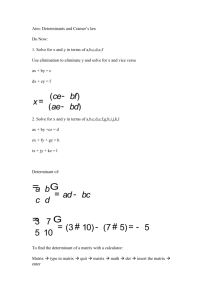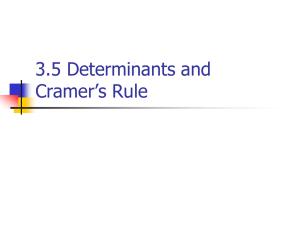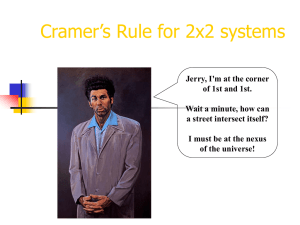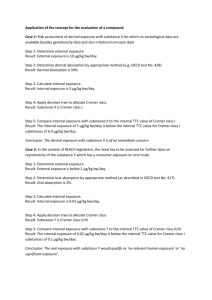Cramer's Rule
advertisement
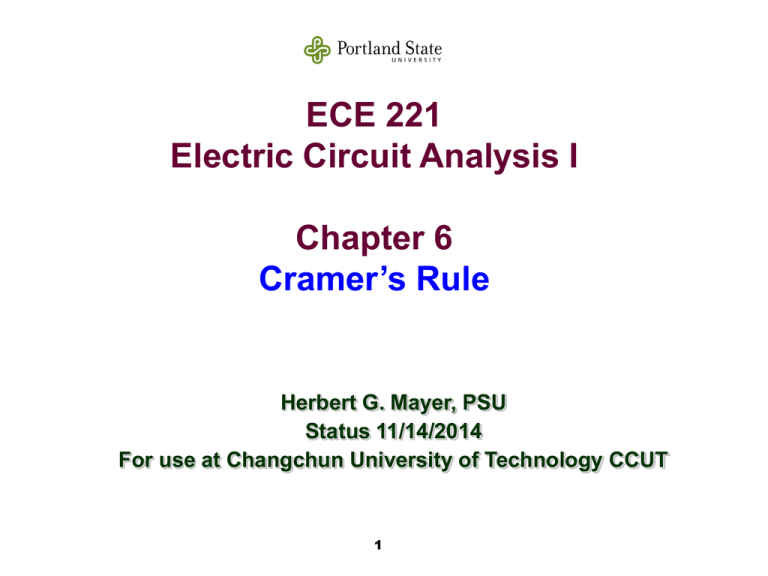
ECE 221 Electric Circuit Analysis I Chapter 6 Cramer’s Rule Herbert G. Mayer, PSU Status 11/14/2014 For use at Changchun University of Technology CCUT 1 Syllabus Motivation Steps for Cramer’s Rule Cramer’s Rule: ∆ Cramer’s Rule: Numerator Ni Cramer’s Rule: Solve for xi Sample Problem 2 Motivation Circuit analysis involves solution of multiple (n) linear equations One way to solve is via substitution Which becomes tedious and highly error-prone, once n is interestingly large Engineering calculators often provide built-in solution, a method internally using Cramer’s Rule Yet future engineers in China must understand the method first; then they should use a calculator First you must learn to use determinants to solve i = 1..n unknowns xi in a set of n linear equations Requirement: n independent equations for n independent unknowns xi 3 Cramer’s Rule Solving Unknowns xi ∆ is the Characteristic Determinant, used in every equation in the denominator of xi N i are the numerators for xi Then for each xi its equation is: xi = N i / ∆ x1 = N1 / ∆ x2 = N2 / ∆ x3 = N3 / ∆ 4 Steps for Cramer’s Rule To start, normalize: Order all equations by index of the unknowns xi to be computed Requires and ends up being a square matrix! If any unknown xi does not occur in an equation, insert it with constant factor ci,j = 0 Compute the characteristic determinant ∆ for the denominator And then, for each unknown xi compute its associated numerator determinant Ni Finally solve for all xi xi = N i / ∆ 5 Steps for Cramer’s Rule Counting of rows and columns starts at 1; not at 0, not like the first index of C or C++ arrays! The unknowns xi are to be computed Constants in each row i that multiply each unknown xj in column j are shown as ci,j The right hand side of = forms a separate column vector of result values Ri 6 Equations for Cramer’s Rule, With n=3 The 3 unknowns xi to be computed are x1 x2 x3 x1 * c1,1 + x2 * c1,2 + x3 * c1,3 = R1 x1 * c2,1 + x2 * c2,2 + x3 * c2,3 = R2 x1 * c3,1 + x2 * c3,2 + x3 * c3,3 = R3 7 Cramer’s Rule: ∆ Write the characteristic determinant ∆ by listing only and all coefficients ci,j in the n rows and n columns Then write the single column for the vertical Results vector R ∆ = |c1,1 |c2,1 |c3,1 c1,2 c2,2 c3,2 c1,3| c2,3| c3,3| [R]= 8 | R1| | R2| | R3| Cramer’s Rule: ∆ Pick an arbitrary column, e.g. column 1, then remove one of its elements ci,1 i=1..n at a time, starting with row 1 Generate the next minor matrix, by eliminating the whole rowi and columnj, initially j = 1; etc. for all rows 1..n Multiply the remaining minor matrix by that constant ci,1 and by its sign; sign = (-1)row+col here = (-1)i+1 ∆ ∆ = c1,1 = |c2,2 c2,3| - c2,1 |c1,2 c1,3| + c3,1 |c1,2 c1,3| |c3,2 c3,3| |c3,2 c3,3| c1,1 * ( c2,2 * c3,3 - c3,2 * c2,3 ) - c2,1 * ( c1,2 * c3,3 - c3,2 * c1,3 ) + c3,1 * ( c1,2 * c2,3 - c2,2 * c1,3 ) 9 |c2,2 c2,3| Cramer’s Rule: Numerator Ni = N1 Starting with characteristic Determinant ∆ Replace ith column for computing xi, and replace that column by result vector [R]; so for x1 we generate: |R1 N1 = |R2 |R3 c1,2 c2,2 c3,2 c1,3| c2,3| c3,3| N1 = R1 N1 = R1* ( c2,2 * c3,3 - c3,2* c2,3 ) - R2* ( c1,2 * c3,3 - c3,2* c1,3 ) + R3* ( c1,2 * c2,3 – c2,2* c1,3 ) |c2,2 c2,3| - R2 |c1,2 c1,3| + R3 |c3,2 c3,3| |c3,2 c3,3| 10 |c1,2 c1,3| |c2,2 c2,3| Cramer’s Rule: Numerator N2 N2 |c1,1 R1 c1,3| = |c2,1 R2 c2,3| |c3,1 R3 c3,3| N2 = c1,1 |R2 c2,3| - c2,1 |R3 c3,3| |R1 c1,3| + c3,1 |R1 c1,3| |R3 c3,3| |R2 c2,3| N2 = c1,1 * ( R2 * c3,3 - R3* c2,3 ) - c2,1 * ( R1 * c3,3 - R3* c1,3 ) + c3,1 * ( R1 * c2,3 - R2* c1,3 ) 11 Cramer’s Rule: Numerator N3 N3 |c1,1 c1,2 = |c2,1 c2,2 |c3,1 c3,2 | c2,2 | c3,2 R1| R2| R3| N3 = c1,1 R2 | - c2,1 |c1,2 R1 | + c3,1 R3 | |c3,2 R3| N3 = c1,1* ( R3 * c2,2 - R2* c3,2 ) - c2,1* ( R3 * c1,2 - R1* c3,2 ) + c3,1* ( R2 * c1,2 - R1* c2,2 ) 12 |c1,2 R1 | |c2,2 R2 | Cramer’s Rule: Solve for xi For each xi its equation is: xi = N i / ∆ x1 = N1 / ∆ x2 = N2 / ∆ x3 = N3 / ∆ 13 Sample Problem, [1] Appendix A Below are 3 sample equations for some circuit The 3 unknowns vi to be computed are v1 v2 v3 21 * v1 - 9 * v2 - 12 * v3 = -33 -3 * v1 + 6 * v2 - 2 * v3 = 3 -8 * v1 - 4 * v2 + 22 * v3 = 50 14 Characteristic Determinant ∆ Now we write result column and the characteristic determinant ∆ by listing coefficients ci,j only ∆ = |21 |-3 |-8 ∆ = 21 | 6 |-4 -9 -12| 6 -2| -4 22| [R]= -2 | - (-3) |-9 22 | |-4 | -33 | | 3 | | 50 | -12 | 22 | -8 |-9 | 6 ∆ = 21*(132-8) + 3*(-198-48) - 8*(18+72) ∆ = 2,604 – 738 - 720 = 1,146 15 -12| -2| Numerator N1 Replace column 1 with column vector [R] N1 N1 = |-33 -9 -12| = | 3 6 -2| | 50 -4 22| -33 |6 -2 | |-4 22 | - 3 |-9 -12| + 50 |-9 -12| |-4 22| | 6 -2| N1 = -33*(124) - 3*(-246) + 50*(18+72) N1 = 1,146 16 Numerator N2 Replace column 2 with column vector [R] N2 N2 = |21 = |-3 |-8 -33 3 50 21 | 3 -2 | + 3 |50 22 | -12 -2 22 | | | |-33 -12| - 8 | 50 22| |-33 -12| | 3 -2| N2 = 21*(166) + 3*(-126) - 8*(102) N2 = 3,486 – 378 – 816 = 2,292 17 Numerator N3 Replace column 3 with column vector [R] N3 N3 = |21 = |-3 |-8 -9 6 -4 21 | 6 3 | + 3 |-4 50 | -33 | 3 | 50 | |-9 -33 | - 8|-9 -33 |-4 50 | | 6 N3 = 21*(312) + 3*(-582) - 8*(171) N3 = 6,552 – 1,746 – 1,368 = 3,438 18 | 3 | Cramer’s Rule: Solve for v1, v2, and v3 For all vi the results are: vi = Ni/ ∆ v1 = N1 / ∆ = 1,146 / 1,146 = 1 V v2 = N2 / ∆ = 2,292 / 1,146 = 2 V v3 = N3 / ∆ = 3,438 / 1,146 = 3 V 19 What if? What would the result be, if we had expanded the characteristic determinant ∆ along the 3rd column? Let’s see: ∆ = |21 |-3 |-8 -9 -12| 6 -2| -4 22| ∆ = -12 |-3 6 | - (-2) |21 |-8 -4 | |-8 -9 | + 22 |21 -4 | |-3 -9| 6| ∆ = -12*(12+48) + 2*(-84-72) + 22*(126-27) ∆ = -720 – 312 + 2,178 = 1,146 <- same result!! 20 What if? One of the beauties of Cramer’s Rule: we may expand the characteristic determinant ∆ in whichever way we like, along any column, along any row! Result is consistently the same That is mathematical beauty! 21
